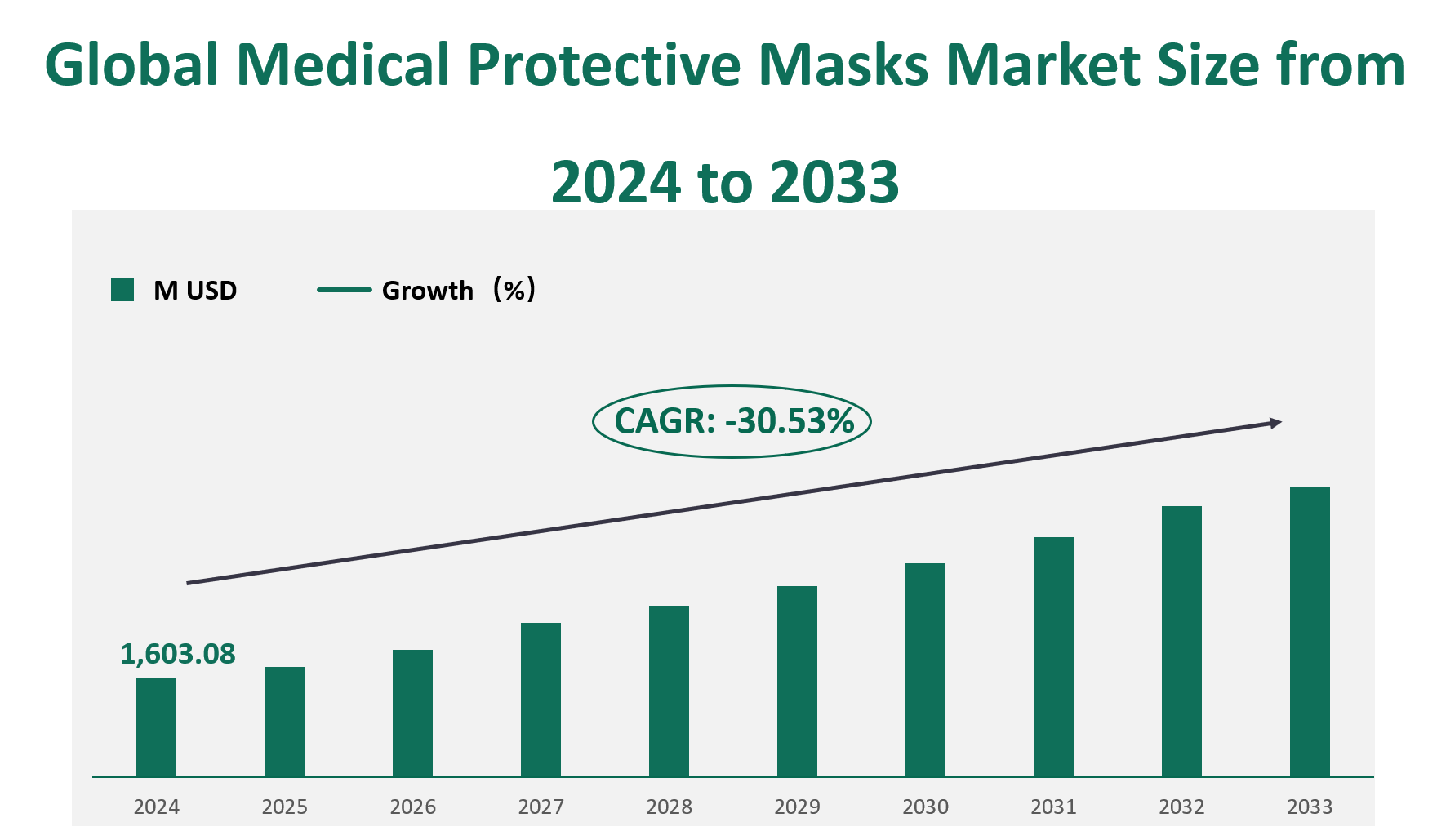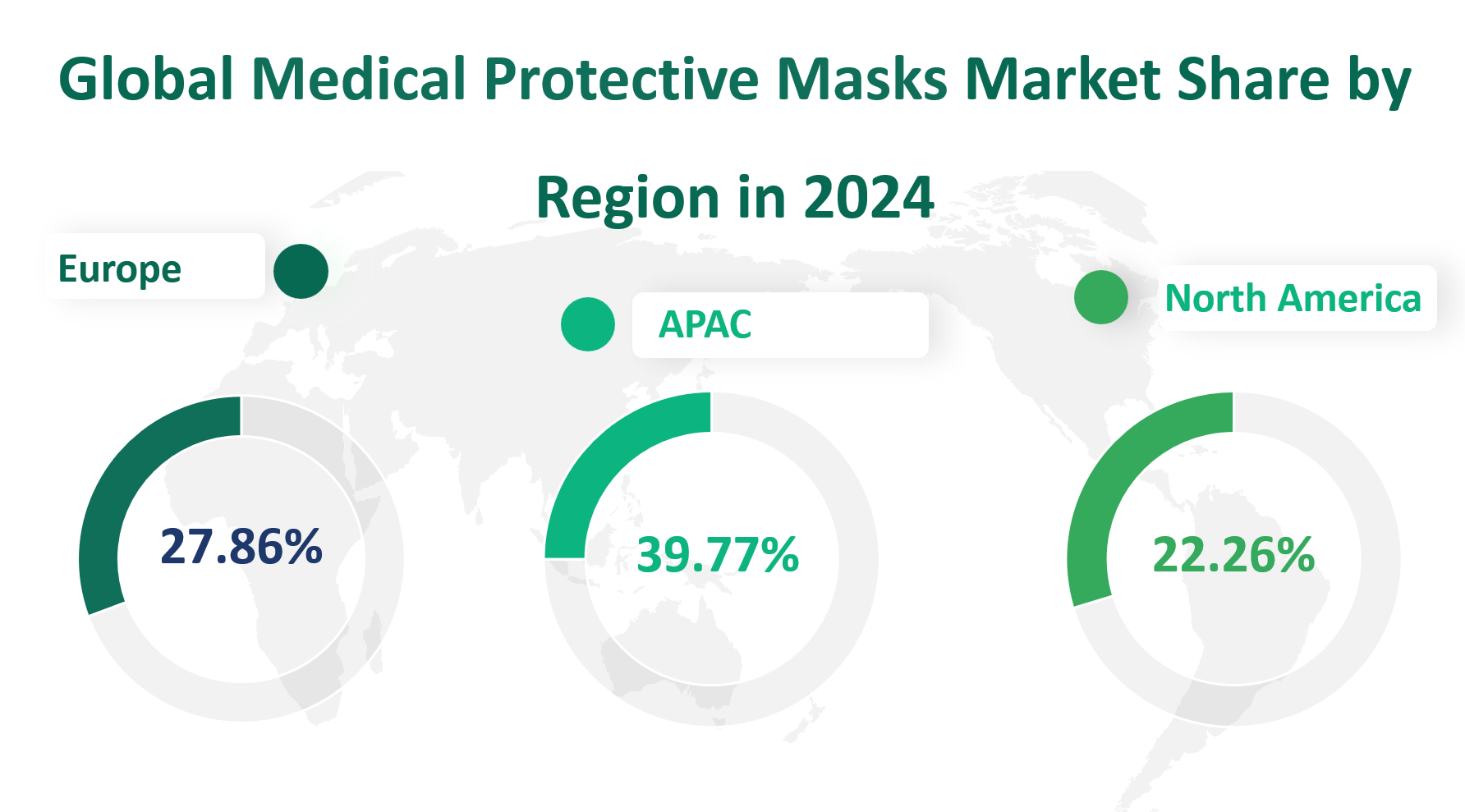1. Global Medical Protective Masks Market Insight Analysis
The global revenue for the Medical Protective Masks market in 2024 is estimated at $1,603.08 million, with a Compound Annual Growth Rate (CAGR) of -30.53% from 2024 to 2033.
Medical Protective Masks are essential personal protective equipment (PPE) designed to filter out airborne particles and protect the wearer from harmful substances, including pathogens, dust, and chemical droplets. These masks typically consist of three layers: an outer layer that repels fluids, a middle filtration layer, and an inner layer that absorbs moisture. They are widely used in healthcare settings, industrial environments, and by the general public to prevent the spread of infectious diseases. The market for these masks has seen unprecedented growth during the COVID-19 pandemic, driven by increased awareness of airborne transmission and the need for personal protection. However, as the pandemic recedes, the market adjust to more normalized levels of demand.
Figure Global Medical Protective Masks Market Size (M USD) and CAGR (2024-2033)

2. Driving and Limiting Factors of Medical Protective Masks Market Growth
The growth of the Medical Protective Masks market is influenced by several key factors. On the positive side, the increasing prevalence of infectious diseases, such as COVID-19, has significantly boosted the demand for protective masks. Governments and health organizations worldwide have mandated the use of masks in public spaces and healthcare settings, further driving market expansion.
Additionally, the growing awareness of the protective benefits of masks among the general public has led to a sustained increase in usage, even beyond the pandemic period. The market has also benefited from continuous product innovation, with manufacturers developing more efficient and comfortable mask designs to meet evolving consumer needs.
However, the market also faces several limiting factors. One of the primary challenges is the low profit margin, which can hinder market revenue growth. The mandatory use of masks during the pandemic led to increased production costs and pricing pressures, compressing profit margins for manufacturers.
Additionally, the market is becoming increasingly competitive, with new entrants and existing players vying for market share through aggressive pricing strategies. This competition may further reduce profit margins and limit the growth potential for some companies.
3. Technology Innovation and Corporate Mergers and Acquisitions in Medical Protective Masks Market
The Medical Protective Masks market has witnessed significant technological innovation and corporate activity in recent years. Technological advancements have led to the development of more efficient filtration materials and mask designs that offer better protection and comfort. For example, some manufacturers have introduced masks with improved breathability, reduced fogging, and enhanced filtration capabilities. These innovations are crucial for maintaining consumer interest and meeting regulatory standards.
Corporate mergers and acquisitions have also played a significant role in shaping the market landscape. For instance, the acquisition of Halyard Health’s Surgical & Infection Prevention (S&IP) business by Owens & Minor in 2018 expanded the latter’s presence in the medical products segment. This acquisition allowed Owens & Minor to leverage Halyard Health’s expertise and product portfolio, enhancing its market position and growth potential. Other companies, such as Honeywell, have ramped up production in response to increased demand, further consolidating their market presence.
4. Global Medical Protective Masks Market Size by Type
Medical protective masks are essential tools in preventing the spread of infectious diseases and protecting individuals from airborne particles. The market for these masks is primarily divided into two major product types: Disposable Masks and Reusable Masks.
Disposable masks are designed for single-use applications. They are typically made from non-woven materials and are intended to protect the wearer from dust, pathogens, and other airborne contaminants. These masks are widely used in healthcare settings, industrial environments, and by the general public due to their convenience and affordability. The revenue for disposable masks in 2024 is approximately USD 241.55 million.
Reusable masks are made from high-quality materials that are breathable, washable, and durable. These masks are designed for multiple uses and are often preferred for their environmental sustainability and cost-effectiveness. Reusable masks can effectively filter out dust, pollen, and other pollutants, making them suitable for long-term use in various settings. The revenue for reusable masks in 2024 is forecasted to be around USD 1,361.53 million.
Table Global Medical Protective Masks Market Size by Type in 2024
Market Size (M USD) 2024 | Market Share | |
Disposable Masks | 241.55 | 15.07% |
Reusable Masks | 1361.53 | 84.93% |
5. Global Medical Protective Masks Market Size by Application
Medical protective masks are utilized across various sectors, each with distinct requirements and usage patterns. The primary applications include Industrial & Business, Individual Use, Hospital & Clinic, and Other applications.
Industrial & Business segment includes the use of protective masks in industrial settings, manufacturing units, and business environments where workers are exposed to dust, chemicals, and other airborne contaminants. Protective masks are essential for ensuring worker safety and compliance with occupational health and safety regulations. The revenue for the Industrial & Business application in 2024 is approximately USD 445.35 million.
Individual use encompasses the general public’s adoption of protective masks for personal protection against air pollution, allergens, and infectious diseases. The COVID-19 pandemic has significantly increased awareness and usage of protective masks among individuals. The revenue for individual use applications in 2024 is forecasted to be around USD 271.14 million.
Protective masks are a critical component of personal protective equipment (PPE) in healthcare settings. They are used by healthcare workers to protect against infectious diseases, surgical infections, and other airborne contaminants. The use of high-quality, certified masks is essential in hospitals and clinics to ensure patient and staff safety. The revenue for Hospital & Clinic applications in 2024 is forecasted to be approximately USD 750.44 million.
Table Global Medical Protective Masks Market Size by Application in 2024
Application | Market Size (M USD) 2024 |
Industrial & Business | 445.35 |
Individual | 271.14 |
Hospital & Clinic | 750.44 |
Others | 136.14 |
6. Global Medical Protective Masks Market by Top Regions
Asia Pacific is projected to be the largest regional market for Medical Protective Masks in 2024, with a revenue forecast of $637.57 million. This region’s dominance can be attributed to several factors, including a high population density, rapid industrialization, and increasing healthcare expenditure.
Europe is expected to hold the second-largest share of the global Medical Protective Masks market in 2024, with a revenue forecast of $446.58 million. The region’s robust healthcare infrastructure and stringent regulations on PPE quality contribute to its strong market presence.
North America is forecasted to generate a revenue of $356.78 million in 2024, making it the third-largest regional market. The United States and Canada have been key players in this region, with a strong emphasis on healthcare safety and regulatory compliance. The market in North America is characterized by a high level of consumer awareness and demand for high-quality protective masks.
Latin America and the Middle East & Africa are emerging markets with significant growth potential. Latin America is expected to generate a revenue of $98.22 million in 2024, while the Middle East & Africa region is forecasted to reach $63.92 million.
Figure Global Medical Protective Masks Market Size by Region in 2024

7. Global Medical Protective Masks Market Analysis by Major Players
7.1 3M
Introduction and Business Overview:
3M is a multinational conglomerate founded in 1902, with operations spanning electronics, telecommunications, healthcare, safety, and other markets. The company is renowned for its innovative products and technologies, serving customers worldwide.
Products Offered:
3M offers a wide range of medical protective masks, including the 3M™ Aura™ Health Care Particulate Respirator and Surgical Mask. These masks are designed to provide respiratory protection against airborne particles and are approved by NIOSH and FDA.
7.2 Halyard Health
Introduction and Business Overview:
Halyard Health, now part of Owens & Minor, focuses on delivering clinically superior infection prevention and surgical solutions. Established in 1872, the company has a strong presence in healthcare markets globally.
Products Offered:
Halyard Health offers a variety of medical protective masks, such as the FLUIDSHIELD* Level 1 Fog-Free Procedure Mask. These masks are designed to provide protection against fluid exposure and are widely used in healthcare settings.
7.3 Cardinal Health
Introduction and Business Overview:
Cardinal Health, founded in 1971, is a global healthcare services and products company. The company provides a wide range of medical products and pharmaceuticals, serving hospitals, healthcare systems, and other medical facilities worldwide.
Products Offered:
Cardinal Health offers ASTM Level 1 Surgical Masks, which are designed for general use in low-fluid cases. These masks are known for their cost-effectiveness and reliability.

